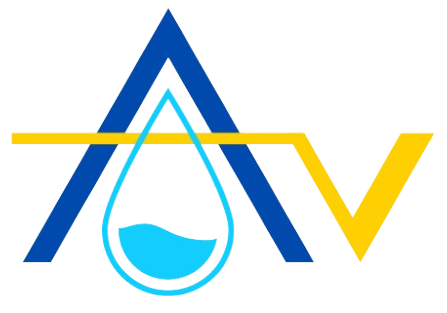Swimming Pool Construction: Start to Finish Guide

Swimming pool construction is a step-by-step process from start to finish. It helps to build a pool without any defects, including cracks and damage, that cause leaking and prevent additional cost, and increase the efficiency in the process.
In this step-by-step process, first you should select the location, then choose a swimming pool type. Next, find a pool contractor and ask him for the estimated cost, and choose the pool type according to your budget and requirements. Next, you should choose the materials. Then start the construction by excavating the ground.
When building a pool, excavate the ground to the recommended depth according to the type of pool you are installing. During pool construction, you should install a waterproofing membrane to prevent water leaks through the pool shell.
Additionally, you should have a rough estimate of the time required and when to start pool construction to minimize environmental impacts, such as rain and groundwater. Aqviz experts highly recommend that you not start pool construction DIY unless you have tools and expert knowledge. It will waste your time and money by raising many problems.
Contact Aqviz experts, and we will help you to waterproof your swimming pool from start to finish. We are available 24/7.
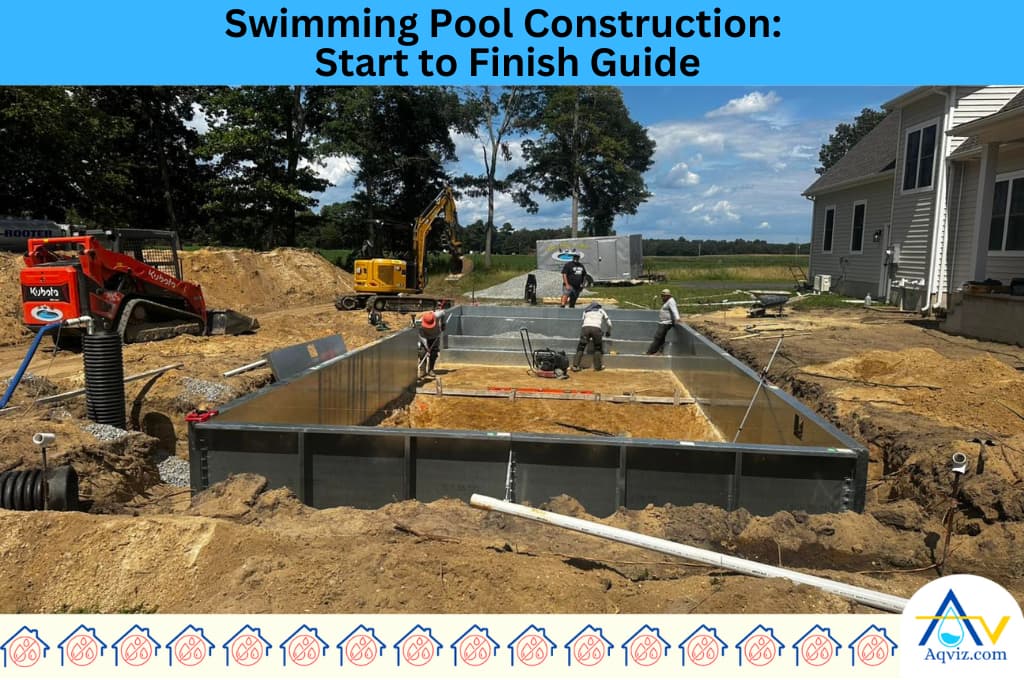
How to Select a Location for a Swimming Pool?
To select a location for a swimming pool, you should select these 5 ground conditions, including: lower ground slope, lower groundwater table, sandy soil condition, rare ground flooding, and stable backfill.
A gentle slope provides natural drainage around the pool area. A low groundwater table prevents hydrostatic pressure on the pool structure. Sandy soil ensures proper load distribution and efficient groundwater movement. Flood-free land avoids structural damage during the rainy season, and compact backfill reduces settlement risks over time.
The importance of selecting these ground conditions lies in creating a durable foundation for the swimming pools that resists cracks, water intrusion, and efflorescence. If the soil drains effectively and groundwater pressure stays low, the swimming pool maintains structural integrity for decades. Our experience has shown that poor site conditions consistently lead to costly repairs in swimming pools, whereas carefully chosen locations ensure stability, safety, and long-term performance.
How to Choose a Swimming Pool Type?
To choose a swimming pool type, you should consider the three main outdoor options, including concrete pools, fiberglass pools, and vinyl liner pools. Each type offers unique advantages depending on budget, durability needs, and maintenance expectations.
If you choose a concrete pool , it has complete design flexibility, high structural strength, resistance against sharp objects, and a lifespan exceeding 30 years. Concrete becomes suitable for homeowners who want custom shapes, unique features, and long-term durability even in challenging soil conditions.
If you choose fiberglass pools , it has a smooth, non-porous surface that resists algae, quick installation that often takes only weeks, reduced chemical usage, and minimal long-term maintenance.
If you choose vinyl liner pools , it has a lower initial cost, customizable patterns and shapes, smooth skin-friendly surfaces, and easier liner replacement every 10–12 years.
Each option suits different needs depending on budget, design goals, and ground conditions.
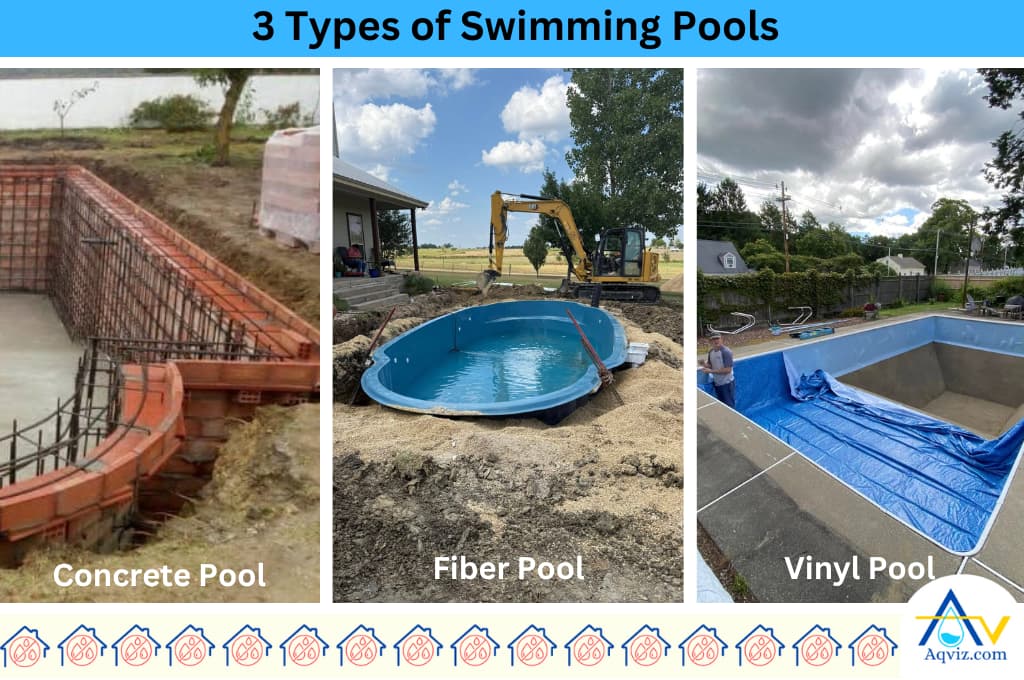
What Type of Swimming Pool can be Built Fast?
If you want a swimming pool that can be built fast, fiberglass pools are the quickest option . Fiberglass swimming pools arrive as pre-molded shells that installers set into the excavation, cutting construction time to just 2-3 weeks. The smooth, factory-finished fiberglass surface eliminates curing delays and reduces on-site labor compared to concrete swimming pools.
If you choose vinyl liner pools, installation takes longer than fiberglass but is still faster than concrete, usually 4-6 weeks.
If you choose concrete pools, construction requires 3-6 months because of curing, plastering, and customization steps. Concrete swimming pools have a longer lifespan and require minimal maintenance and repairs.
How to Find a Swimming Pool Contractor?
To find a swimming pool contractor, you should look at the most trusted companies in the USA that specialize in outdoor pool construction and maintenance.
These are the best swimming pool construction and service providers all over the USA.
- Aqviz Waterproofing provides expert waterproofing services that protect pools and surrounding structures from leaks, seepage, and water damage.
- Premier Pools & Spas is known for large-scale custom pools with decades of experience.
- California Pools offers innovative design options with energy-efficient systems.
- Blue Haven Pools & Spas delivers nationwide service with strong warranties and financing support.
- Riverbend Sandler Pools focuses on luxury pool construction with award-winning designs.
Choosing a swimming pool contractor from these established names ensures quality workmanship, adherence to safety standards, and reliable after-service support.
Swimming pool contractors with proven track records handle soil conditions, drainage layouts, and waterproofing systems effectively, which reduces long-term repair costs and extends pool life.
A well-chosen professional makes the difference between a pool that endures decades and one that suffers recurring failures.
How much does it Cost for Swimming Pool Construction?
Swimming pool construction cost can be categorized into 4 main sub-categories, including pool excavation, pool installation, waterproofing, and finishing.
Swimming pool excavation and floor preparation usually costs between $5,000-$10,000 (USD), depending on soil type, slope, and accessibility.
Concrete swimming pool construction ranges from $50,000-$100,000 (USD) because of labor, steel reinforcement, and curing requirements. Concrete pool waterproofing adds $5,000–$15,000 (USD), depending on membrane type and coating system.
Fiberglass swimming pool installation typically costs $40,000-$85,000 (USD), including shell placement and plumbing.
Vinyl liner swimming pool installation falls in the $25,000-$55,000 (USD) range, with additional costs for liner replacement every 10-12 years.
After works such as pool lighting, decking, fencing, and landscaping, they generally add another $10,000-$30,000 (USD) to the total project budget. Careful planning of each stage helps avoid unexpected cost escalations.
What Materials can be used for Swimming Pool Construction?
The materials that can be used for the pool construction depend on the pool type you use:
Materials for concrete swimming pools: Reinforced steel rebar, shotcrete or gunite mix, waterproofing membranes, epoxy coatings, plaster finishes, and ceramic tiles.
Materials for fiberglass swimming pools: Pre-molded fiberglass shells, gelcoat surface layers, polyester resin, waterproof joint sealants, gravel, and sand bedding.
Materials for vinyl liner swimming pools: Vinyl liner sheets, polymer or steel wall panels, coping tracks, waterproof adhesives, wall braces, and backfill material.
Each material group is selected to ensure strength, effective waterproofing, and long-lasting performance for the chosen pool type.
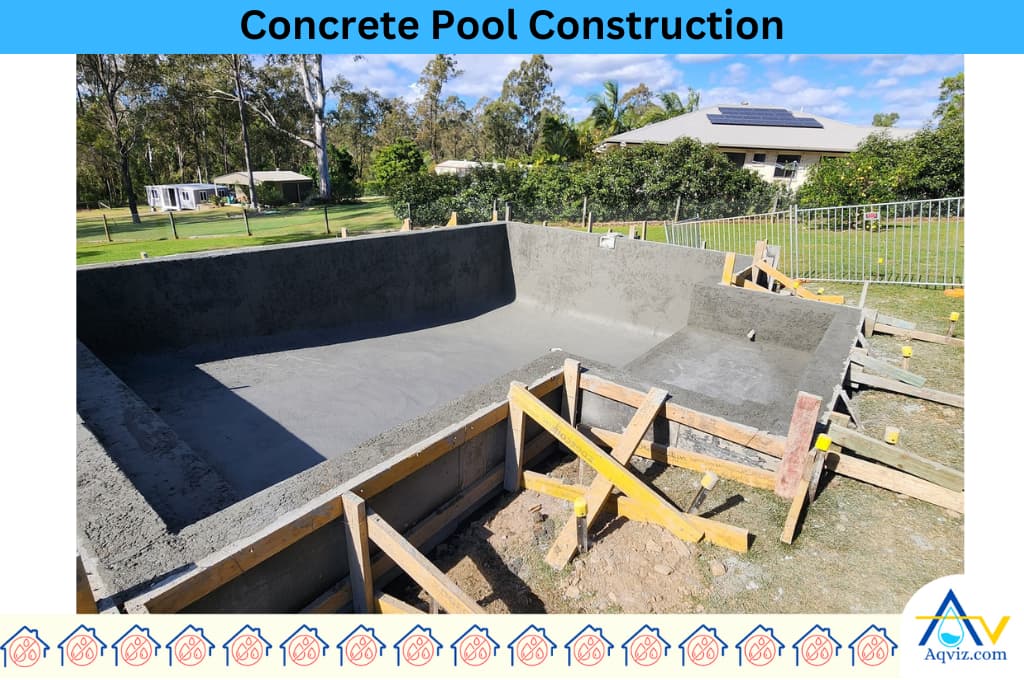
What are the 7 Steps for Swimming Pool Construction?
Swimming pool construction follows 7 structured steps.
- Site layout and excavation: First, you should mark the pool perimeter with chalk lines and stakes, remove soil using excavators or backhoes, and dig to the correct depth while avoiding unstable ground.
- Floor preparation and base compaction: Next, you should spread gravel or sand, compact it with plate compactors, and level the base using rakes and laser levels for a stable foundation.
- Wall framework or shell placement: Then, you should install steel rebar and wooden or metal formwork for concrete, assemble polymer or steel panels for vinyl, or lower fiberglass shells into place using cranes.
- Plumbing and electrical installation: You should add PVC pipes, skimmers, drains, and conduits with pipe cutters, solvent cement, and wiring tools to ensure proper circulation and lighting.
- Waterproofing and liner application: Next, you should apply waterproofing membranes and coatings with rollers or sprayers for concrete, stretch vinyl liners with vacuums for tight fitting, or seal fiberglass joints with resin to avoid leakage.
- Coping, decking, and surface finishing: Then, you should set coping stones with mortar, pour concrete or install pavers for decking, and finish surfaces with plaster, tile, or stamped concrete.
- Filling, equipment setup, and chemical balancing: Finally, you should fill the pool with water using hoses, connect pumps, filters, and heaters with wrenches and sealants, and test water chemistry with pH kits and chlorine tablets for safe swimming.
Read More About: What to Know about Swimming Pool Waterproofing? Old and New
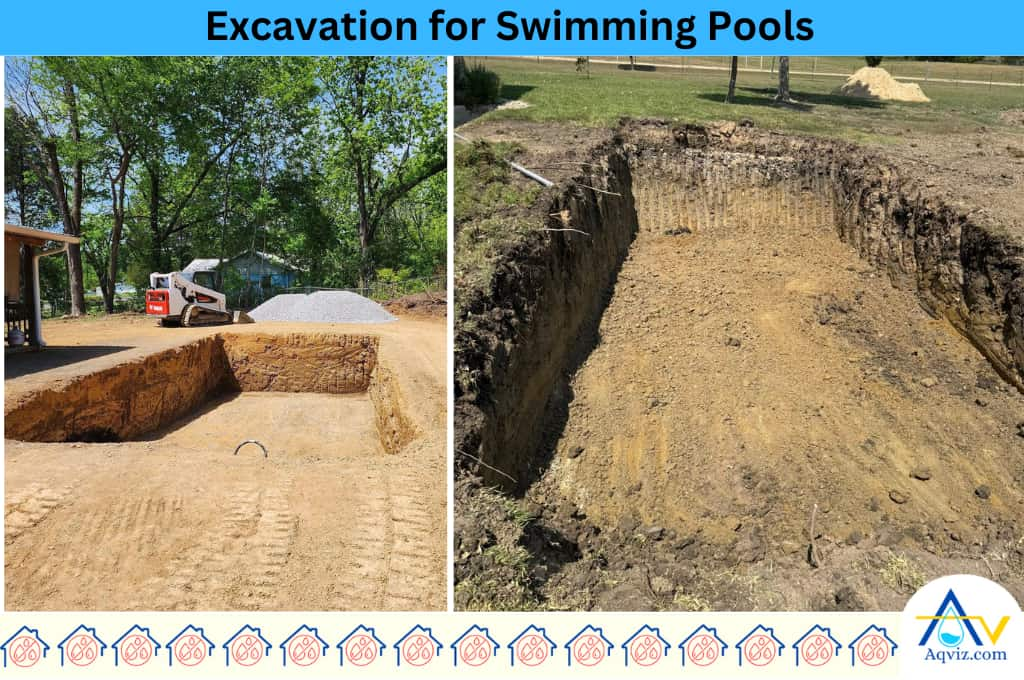
How Deep Should I Excavate for a Swimming Pool?
The deeper swimming pool types are concrete pools and vinyl liner pools. Fiberglass pools are not as deep as concrete and vinyl pools because they come in pre-molded shells with limited depth options.
Hence, a concrete swimming pool should be excavated more than 6 feet at the standard deep end, while 3-4 feet in the shallow end.
A vinyl liner swimming pool also requires excavation of around 8-10 feet in the deep end with 3-4 feet in the shallow section.
A fiberglass swimming pool excavation usually depends on the fiberglass pool type you are going to build. You should contact the fiberglass pool manufacturer before excavating for the swimming pools.
These depths allow safe diving zones, comfortable shallow areas, and proper water circulation over the pool area.
How Long Does It Take to Build a Swimming Pool?
The total construction time of a swimming pool depends on the swimming pool type and complexity. In total, fiberglass pools can be completed in 3-5 weeks, vinyl liner pools in 5-7 weeks, and concrete pools in 3-6 months.
Regular time period for swimming pool construction based on tasks.
- Excavation usually takes around 2 days, depending on soil conditions and site access.
- Floor preparation and base compaction require about 2-3 days.
- Wall framework or shell placement takes 5-7 days for vinyl and fiberglass pools, while concrete pools may take 2-3 weeks due to curing.
- Plumbing and electrical installation normally takes 4-6 days.
- Waterproofing and liner application require 3-5 days, depending on the membrane or liner type.
- Coping, decking, and surface finishing may take 2-3 weeks as materials like tiles, concrete decks, or pavers are installed.
- Filling, equipment setup, and chemical balancing are usually completed within 2-3 days.
When should you Construct a Swimming Pool?
You should start swimming pool construction in late spring or early summer.
The spring or early summer season helps to keep excavation areas dry, ensures lower groundwater levels, and allows concrete or backfill materials to cure properly without excess moisture. Lower humidity also improves waterproofing membrane adhesion and reduces the risk of efflorescence forming on pool surfaces.
As well as you can start this in early fall when rainfall is minimal, soil conditions are stable, and contractors have more availability. Building during dry seasons avoids costly delays, prevents soil collapse, and guarantees that waterproofing layers bond effectively for long-term durability.
Can you Construct a Swimming Pool DIY?
No, swimming pool construction is not suitable as a DIY project. A swimming pool requires heavy excavation equipment, compactors, cranes, and plumbing tools that DIYers do not have. Without proper machinery, digging, leveling, and placing structural components become unsafe and inaccurate.
DIYers also do not know about specialized materials like waterproofing membranes, shotcrete mixes, vinyl liner systems, or fiberglass sealants. Pool construction demands expert knowledge in soil behavior, structural reinforcement, waterproofing, and plumbing layouts. Without this expertise, leaks, cracks, and settlement are unavoidable. For these reasons, professional contractors remain the only safe and reliable choice for swimming pool construction.
What are the Common 10 Problems and Results in Swimming Pool Construction?
When you construct a swimming pool, you can observe the following 10 common problems. Aqviz experts have also included their results.
- Soil instability: Soil instability causes cracks and uneven settlement after swimming pool construction.
- Groundwater seepage: Groundwater seepage leads to hidden leaks inside the swimming pool structure.
- Plumbing issues: Poor plumbing installation causes water leakage and pressure loss in the swimming pool system.
- Waterproofing failure: Waterproofing failure allows seepage and damages the swimming pool tiles, plaster, and concrete.
- Tile and grout damage: Tile popping and grout cracking occur in the swimming pool due to water pressure and weak adhesion.
- Drainage problems: Faulty drainage around the swimming pool causes water accumulation and soil erosion.
- Equipment breakdown: Pump and filtration system breakdown leads to dirty water and poor circulation in the swimming pool.
- Electrical hazards: Improper wiring and a lack of grounding create serious electrical shock risks in the swimming pool area.
- Algae growth: Poor water chemistry and maintenance cause algae growth and slippery surfaces in the swimming pool.
- High maintenance costs: Wrong material selection results in frequent repairs and high upkeep costs for the swimming pool.
How to Protect a Swimming Pool?
To protect the swimming pool, first you should waterproof it. An effective swimming pool waterproofing system helps to prevent leaks, seepage, and structural deterioration. You can use waterproofing membranes such as cementitious coatings, polyurethane membranes, and epoxy coatings for new swimming pools. These membranes block water migration through concrete and create a durable barrier against pressure from inside and outside the pool.
For older swimming pools, protection comes from repairing cracks and damages using epoxy injections, polyurethane grouts, crystalline waterproofing slurries, or patch mortars. After structural repair, a fresh layer of waterproofing membrane can be applied to restore protection. Addressing waterproofing at the right stage during construction and repair ensures pools remain watertight, prevents efflorescence, and extends the service life of the entire system.
Is Cheap Swimming Pool Construction Good?
A cheap swimming pool means using low-cost materials, unskilled labor, and shortcuts during construction to reduce the initial budget. While it may save money at the beginning, it often compromises the structural integrity and waterproofing quality of the pool.
Cheap swimming pools commonly face water problems such as leaks, seepage, and liner wrinkles, along with structural issues like cracks, settlement, and wall bowing. Over time, these defects cause efflorescence, corrosion of reinforcement, and constant repair expenses. Instead of saving, homeowners end up spending more on maintenance and waterproofing treatments throughout the pool’s life. A well-built pool with proper materials and professional workmanship is always a better long-term investment.
